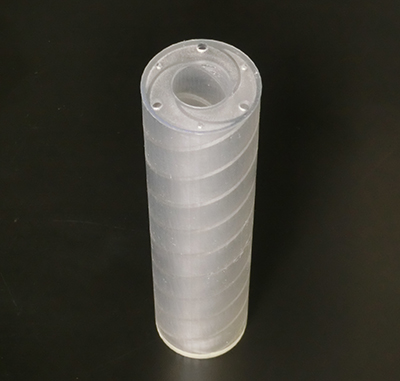Solid, liquid, or gas? That might sound like a question on your high school physics test, but it’s an important consideration when powering a rocket into space.
A team from Aerospace successfully tested a new type of 3-D printed rocket motor that could potentially lead to less expensive and more efficient rocket propellants.
“The Aerospace Corporation created and has led the field of 3-D printed propellant from its beginning, but we’ve never flown any of the technologies we created in this area,” said Jerry Fuller, who came up with the idea in the first place. “This test was the first flight of a novel liquid motor.”
Propulsion Options
Traditionally, there are several types of rocket propulsion systems. Liquid propellants are the most capable, but also the most expensive. Solid propellants are simple, inexpensive, and common. Hybrid propellants (combining solid fuel with a liquid or gas oxidizer) are reasonably inexpensive, but are rarely used since they don’t perform very well. “The truth is hybrids don’t burn fast enough and are not as efficient as they should be,” Fuller said.
New Rocket Motor Takes Flight
Fuller has been investigating ways to 3-D print hybrid motors, and has come up with helical shapes that enable the liquid or gas oxidizer to interact with the solid fuel more effectively and dramatically improve performance.

Not satisfied to stop there, he is now looking at what he calls “Port Injected Liquid” motors. Normally, liquid motors require expensive turbopumps to deliver the fuel and oxidizer. Fuller rearranged the traditional structure of a liquid motor, where the fuel and oxidizer are pumped from low pressure tanks into a thrust chamber, to look more like that of a hybrid rocket, where liquid oxidizer flows through a chamber that contains solid fuel. Here, a printed “liquid fuel grain” stores a liquid fuel and meters the flow of fuel as the oxidizer passes through it. This arrangement can eliminate much or all of the plumbing and turbomachinery typically seen in liquid motors. It also allows liquid motors to be very small and simple and inexpensive.
Fuller and systems engineer John McVey cooked up the idea to test these motors, and they pulled in propulsion science engineer Andrew Cortopassi and amateur high-power rocketry wonk Chris Kobel to complete the task. With Cortopassi’s expertise, the team first tested the motors in Aerospace’s Propulsion Research Facility, and then decided it was time for the motors to, quite literally, take flight.
They packed up their gear and took a field trip to California’s Mojave Desert, where they launched four of their liquid motors and one hybrid motor on high-power hobby rockets. They expected to reach an altitude of 1,000-4,000 feet, but one of the liquid motors exceeded their expectations, reaching a maximum altitude of a little over 5,000 feet, with a maximum velocity of almost 600 mph. These results bode well for the future.
Looking Forward
Fuller emphasizes that the research thus far has been for small motors, like the ones just tested in the Mojave Desert. Larger motors would need to be tested, but with current 3-D printers, creating a fuel grain for a sounding rocket or a small CubeSat launch vehicle is not out of the realm of possibility.
More research is needed, but the potential for a less-expensive, high-performance motor is attractive. As Fuller puts it:
“A simple liquid motor is something that doesn’t really exist at the moment, and if we can find ways, probably through 3-D printing, to manage the delivery of liquid fuel, then we will have made a significant advance in rocket motor technology,” he said. “At the moment it looks like we have found at least one of these ways.”
This technology is available for license.
This technology is available for license.
Technology Transfer at Aerospace
Aerospace has a variety of technologies available for licensing. For commercial companies, Aerospace may offer royalty-bearing exclusive or nonexclusive licenses, options, and low-fee evaluation licenses. For not-for-profits, FFRDCs, universities, and government agencies, Aerospace may offer royalty-free licenses.
Our office can assist you with executing a Non-Disclosure Agreement (NDA), software releases and end-user licenses, as well as patent know-how and copyright licensing.
Contact us at ip@aero.org.

